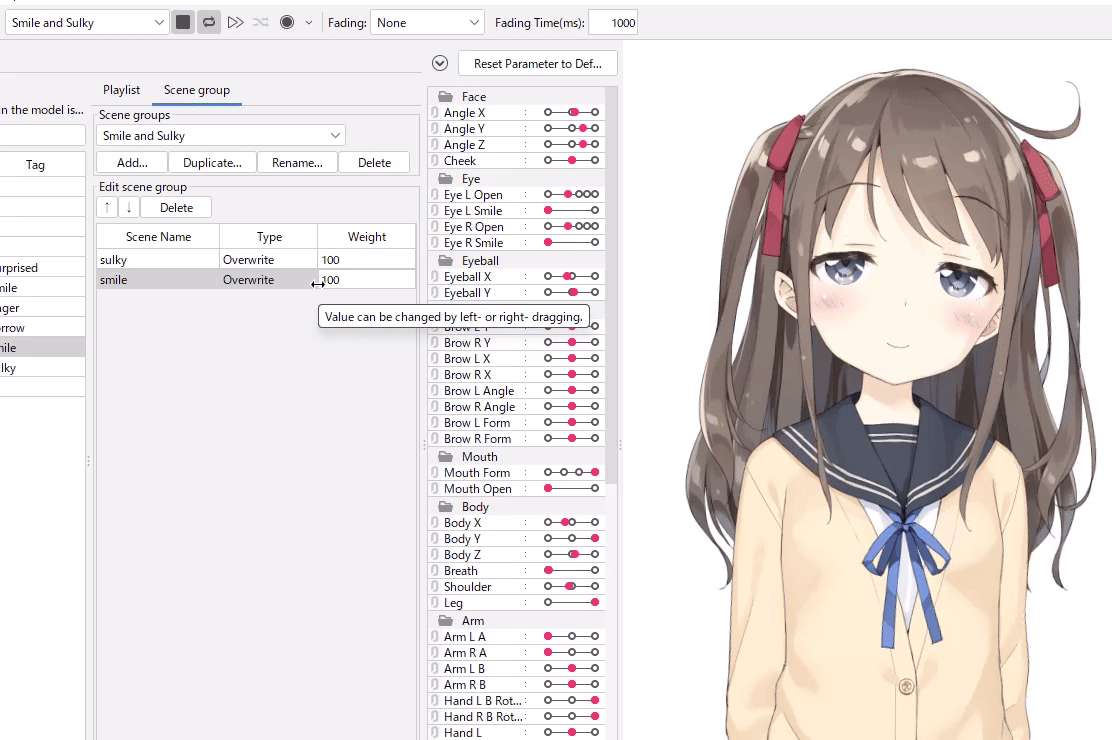How to set up a playlist
Updated: 11/08/2024
This page describes the procedure for setting up a playlist.
See “About Playlist” for a more detailed explanation of the settings screen and more information.
In advance, prepare model data (CMO3) for which you want to set the playlist and the animation data (CAN3) for which you created the scene.
See “Model Loading and Placement” and “Creating Animations” for information on how to create animation data in the Animation Workspace.
Playlist setup procedure
Click on the [Modeling] menu -> [Physics Settings] to open the Physics Settings dialog box.
If the playlist is not set, the setting item is grayed out and the operation is disabled.
Load animation data
| Number | Image | Details |
|---|---|---|
| (1) | 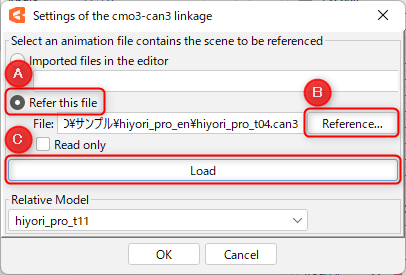 | Load [CAN3]. Click on the [Playlist] menu → [Settings of the cmo3-can3 linkage]. If the Editor has already loaded [CAN3], select the file from the combo box under [Files loaded in the editor] and click [OK]. If [CAN3] is not open, select [Browse files] (A), then select the [CAN3] you want to open from [Reference] (B). Click [Load] (C) to display the [CMO3] associated with [CAN3] in the [Linked models] combo box. Select the model to be tied to the model data currently open in the Editor and click [OK]. |
| (2) |  | Once the [CAN3] file is loaded, you can switch to the [Playlist] tab. |
| (3) | 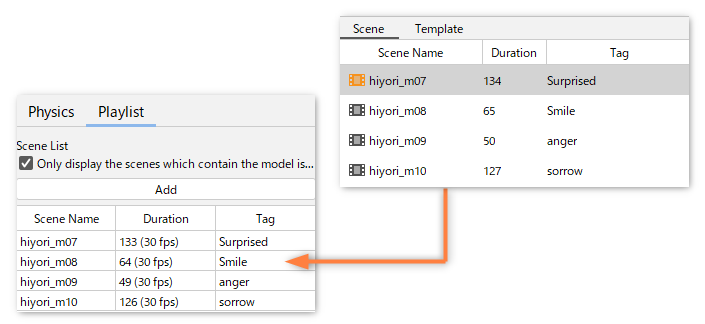 | The scenes in the loaded [CAN3] file will be displayed in the [Scene list]. Note: If a tag is set for a scene, the name will appear in the list with the tag. |
Tips
If you want to only play back scenes without editing the playlist, suppress the GUI settings by checking the [Read only] checkbox.
Create a playlist
| Number | Image | Details |
|---|---|---|
| (1) | 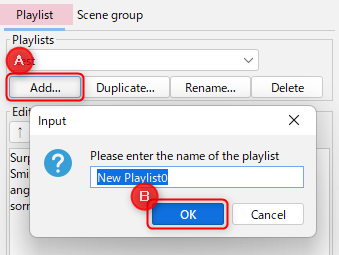 | From the [Playlist] tab, click [Add] (A). Enter any name and click [OK] (B). |
| (2) | 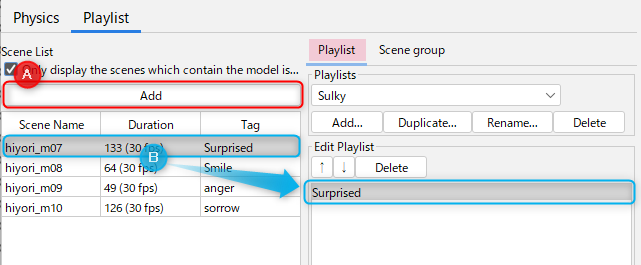 | Once the new playlist has been added, select the scene you want to add from the [Scene List]. With a scene selected, click [Add] (A) in the scene list to add the selected scene to [Edit Playlist]. (B) |
| (3) | 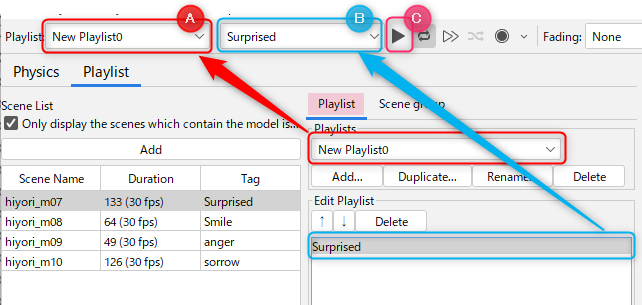 | Select the playlist you created and the scene you want to play from (A) and (B) on the playback bar, and click [Playback] (C) to play the scene. For more information on the playback bar, see “Physics Settings.” |
For models for which physics have been set in advance, select the [Physics] menu → [Enable physics] checkbox to check for shaking during scene playback.
See “How to Set Up Physics” for details on how to set up physics calculations.
Scene Group Setup Procedure
Scene group is a function that combines and plays back separate scenes such as “facial expressions” and “body movements.”
You can check the blend ratio while changing it in real time.
Create a scene group
| Number | Image | Details |
|---|---|---|
| (1) | 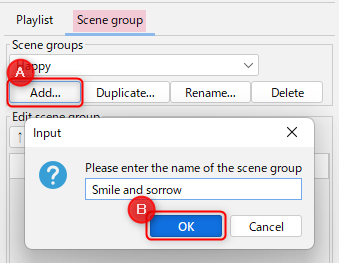 | From the [Scene Group] tab, click [Add] (A). Enter any name and click [OK] (B). |
| (2) | 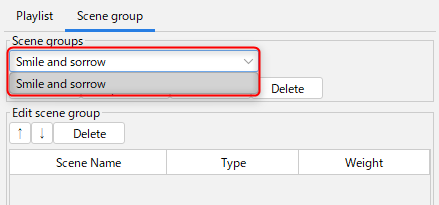 | The created scene group will be added to the [Scene group list]. |
| (3) | 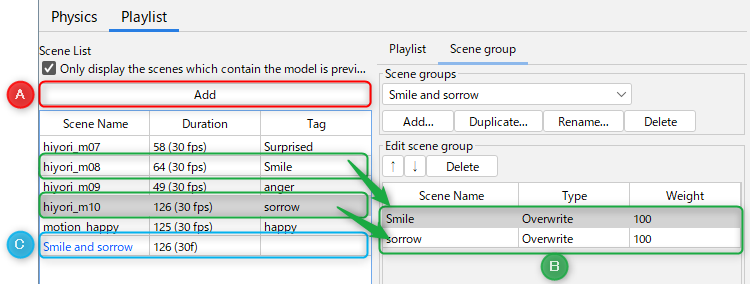 | Select the scenes you want to combine from the [Scene List] and click [Add] (A) to add them to the [Edit Scene Group]. (B) When a scene is added to a scene group, the name of the scene group appears in blue (C) in the scene list. The blend mode for combining scenes can be selected from [Overwrite] and [Additive] under [Type]. [Weight] allows you to set the degree of influence of each scene to a desired value. Note: When blending scenes, they are applied in order from the top. Note: A scene group cannot be added to another scene group. |
| (4) | 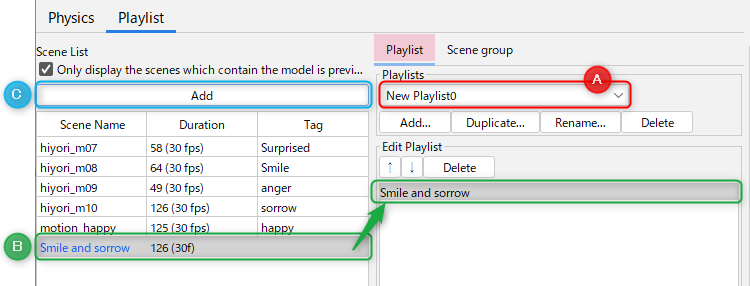 | Switch to the [Playlist] tab and select the desired playlist (A) from the [Playlist List]. Select the scene group you want to add from the [Scene list] (B) and click [Add]. (C) |
| (5) | 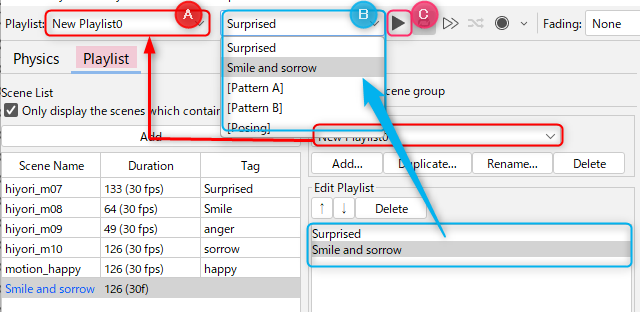 | Select the playlist and the scene group you want to play from (A) and (B) on the playback bar, and click [Playback] (C) to play the scene. |
Point
Settings of playlists and scene groups are saved to animation files (CAN3).
If you want to save the settings, overwrite the animation file.
Check the blending condition while playing back
While playing back the set scene group, by dragging the numeric value of the [Weight], you can see how the blend ratio changes in real time.
Check the View and simulate it.
